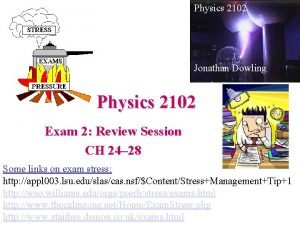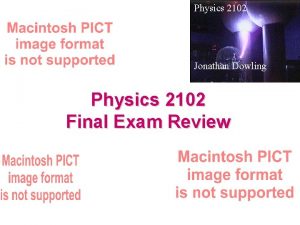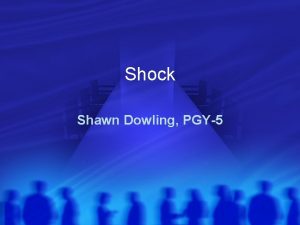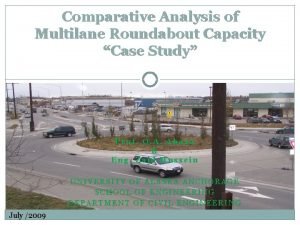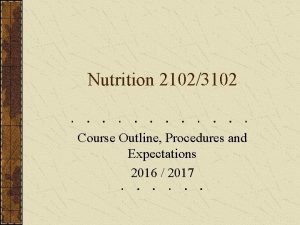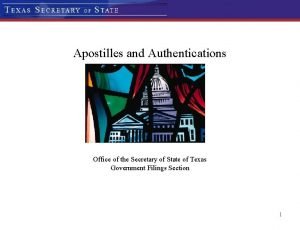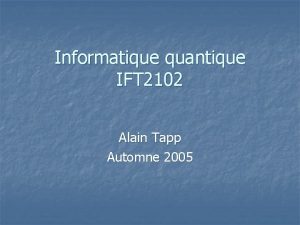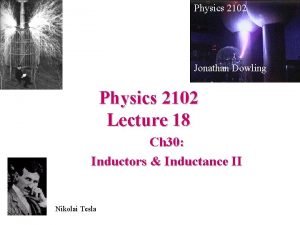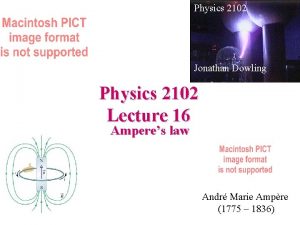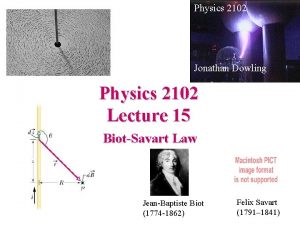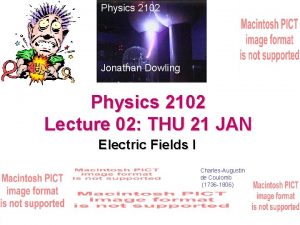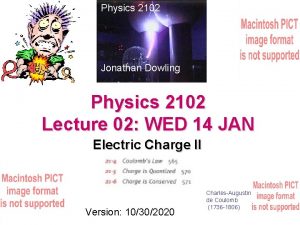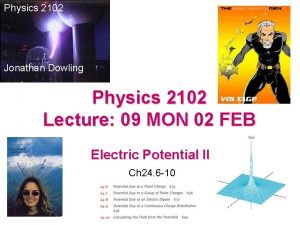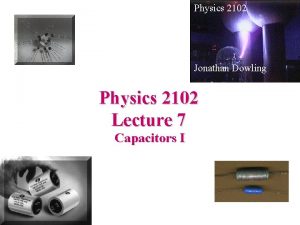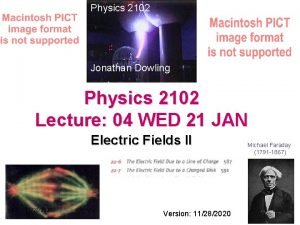Physics 2102 Jonathan Dowling Physics 2102 Lecture 12















- Slides: 15

Physics 2102 Jonathan Dowling Physics 2102 Lecture 12 DC circuits, RC circuits

How to Solve Multi-Loop Circuits

Step I: Simplify “Compile” Circuits Resistors Capacitors Key formula: V=i. R Q=CV In series: same current same charge Req=∑Rj 1/Ceq= ∑ 1/Cj In parallel: same voltage 1/Req= ∑ 1/Rj Ceq=∑Cj

Step II: Apply Loop Rule Around every loop add +E if you cross a battery from minus to plus, –E if plus to minus, and –i. R for each resistor. Then sum to Zero: +E 1 –E 2 – i. R 1 – i. R 2 = 0. E 1 + – R 2 Conservation of ENERGY! E 2

Step II: Apply Junction Rule At every junction sum the ingoing currents and outgoing currents and set them equal. i 1 = i 2 + i 3 i 1 i 2 i 3 Conservation of CHARGE!

Step III: Equations to Unknowns Continue Steps I–III until you have as many equations as unknowns! Given: E 1 , E 2 , i , R 1 , R 2 +E 1 –E 2 – i 1 R 1 – i 2 R 2 = 0 and i = i 1 + i 2 Solve for i 2 , i 3

Example Find the equivalent resistance between points (a) F and H and (b) F and G. (Hint: For each pair of points, imagine that a battery is connected across the pair. ) Compile R’s in Series Compile equivalent R’s in Parallel

Example Assume the batteries are ideal, and have emf E 1=8 V, E 2=5 V, E 3=4 V, and R 1=140 W, R 2=75 W and R 3=2 W. What is the current in each branch? What is the power delivered by each battery? Which point is at a higher potential, a or b? Apply loop rule three times and junction rule twice.

Example • What’s the current through resistor R 1? • What’s the current through resistor R 2? • What’s the current through each battery? Apply loop rule three times and junction rule twice.

Non-Ideal Batteries • You have two ideal identical batteries, and a resistor. Do you connect the batteries in series or in parallel to get maximum current through R? • Does the answer change if you have non-ideal (but still identical) batteries? Apply loop and junction rules until you have current in R.

More Light Bulbs • If all batteries are ideal, and all batteries and light bulbs are identical, in which arrangements will the light bulbs as bright as the one in circuit X? • Does the answer change if batteries are not ideal? Calculate i and V across each bulb. P = i. V = “brightness” or Calculate each i with R’s the same: P = i 2 R

RC Circuits: Charging a Capacitor In these circuits, current will change for a while, and then stay constant. We want to solve for current as a function of time i(t). The charge on the capacitor will also be a function of time: q(t). The voltage across the resistor and the capacitor also change with time. To charge the capacitor, close the switch on a. E + VR(t)+VC(t) =0 E - i(t)R - q(t)/C = 0 E - (dq(t)/dt) R - q(t)/C =0 A differential equation for q(t)! The solution is: q(t) = CE(1 -e-t/RC) And then i(t) = dq/dt= (E/R) e-t/RC i(t) E/R Time constant=RC

RC Circuits: Discharging a Capacitor +++ --- Assume the switch has been closed on a for a long time: the capacitor will be charged with Q=CE. Then, close the switch on b: charges find their way across the circuit, establishing a current. VR+VC=0 -i(t)R+q(t)/C=0 => (dq/dt)R+q(t)/C=0 + -C Solution: q(t)=q 0 e-t/RC=CEe-t/RC i(t) = dq/dt = (q /RC) e-t/RC = (E/R) e-t/RC 0 i(t) E/R

Example The three circuits below are connected to the same ideal battery with emf E. All resistors have resistance R, and all capacitors have capacitance C. • Which capacitor takes the longest in getting charged? • Which capacitor ends up with the largest charge? • What’s the final current delivered by each battery? • What happens when we disconnect the battery? Compile R’s into Req. Then apply charging formula with Req. C =

Example In the figure, E = 1 k. V, C = 10 µF, R 1 = R 2 = R 3 = 1 MW. With C completely uncharged, switch S is suddenly closed (at t = 0). • What’s the current through each resistor at t=0? • What’s the current through each resistor after a long time? • How long is a long time? Compile R 1, R 2, and R 3 into Req. Then apply discharging formula with Req. C =
 Jonathan dowling
Jonathan dowling E=q/ae0
E=q/ae0 Shock mnemonic
Shock mnemonic Dowling optical
Dowling optical Dowling roundabout
Dowling roundabout International human resource management dowling 6th edition
International human resource management dowling 6th edition 01:640:244 lecture notes - lecture 15: plat, idah, farad
01:640:244 lecture notes - lecture 15: plat, idah, farad Nutrition 2102
Nutrition 2102 Nutrition 2102
Nutrition 2102 Nutrition 2102
Nutrition 2102 Texas apostille form 2102
Texas apostille form 2102 Ift-2102
Ift-2102 Classical mechanics
Classical mechanics Physics 101 lecture notes pdf
Physics 101 lecture notes pdf Physics 101 lecture notes pdf
Physics 101 lecture notes pdf Waves physics notes
Waves physics notes
